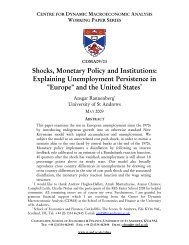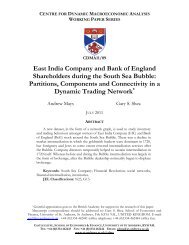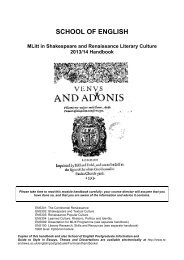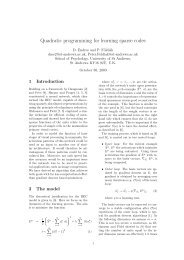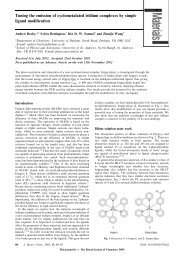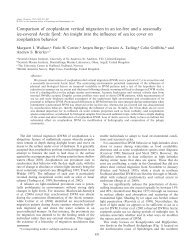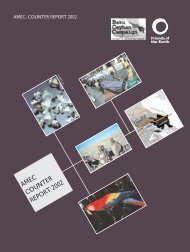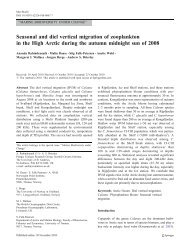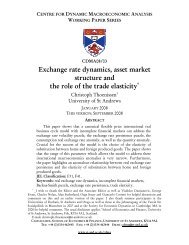introduction what is social anthropology? - University of St Andrews
introduction what is social anthropology? - University of St Andrews
introduction what is social anthropology? - University of St Andrews
You also want an ePaper? Increase the reach of your titles
YUMPU automatically turns print PDFs into web optimized ePapers that Google loves.
HINTS ON WRITING ESSAYS AND<br />
EXAM ANSWERS<br />
SA1001 <strong>is</strong> assessed as follows:<br />
Two assessed essays, each 1500 to 2000 words in length, to be submitted by MONDAY 22 ND<br />
OCTOBER and MONDAY 19 TH NOVEMBER. Each essay <strong>is</strong> worth 30% <strong>of</strong> the final mark.<br />
One two‐hour long examination. The exam <strong>is</strong> worth 40% <strong>of</strong> the final mark.<br />
Please note the following key points:<br />
Essays should be typed and submitted via MMS (https://www.st‐andrews.ac.uk/mms/)<br />
Essays should be properly referenced, especially direct quotations from books and articles, and a<br />
bibliography should be attached. The bibliography should only contain items that have been<br />
specifically referred to in the text. We strongly recommend that you follow the system explained in<br />
the last section <strong>of</strong> th<strong>is</strong> handbook. Consult your lecturer/tutor/superv<strong>is</strong>or if in doubt.<br />
PLAGIARISM<br />
Intentional plagiar<strong>is</strong>m, i.e. the deliberate subm<strong>is</strong>sion <strong>of</strong> someone else's work as though it were<br />
one's own, <strong>is</strong> d<strong>is</strong>honest. But plagiar<strong>is</strong>m may occur unintentionally through poor work practices, as<br />
students may for example submit work that contains the words or ideas <strong>of</strong> others without real<strong>is</strong>ing<br />
that they need proper acknowledgement. The <strong>University</strong>’s Academic M<strong>is</strong>conduct policy refers to<br />
actions rather than intent, and a piece <strong>of</strong> work that contains plagiar<strong>is</strong>ed material will be subject to<br />
a penalty irrespective <strong>of</strong> whether or not there was an intention to plagiar<strong>is</strong>e. It <strong>is</strong> consequently<br />
very important for you to understand how to avoid producing work that contains plagiar<strong>is</strong>ed<br />
material.<br />
Note that copying and pasting material from a web site or book into a piece <strong>of</strong> written work<br />
without due acknowledgement <strong>is</strong> likely to be regarded as plagiar<strong>is</strong>m, even if it <strong>is</strong> just one<br />
sentence that <strong>is</strong> copied.<br />
While students are certainly expected to read the work <strong>of</strong> others, their written work should be in<br />
their own words, and the sources <strong>of</strong> information they are using should be acknowledged in a<br />
footnote, specific reference l<strong>is</strong>t, or bibliography depending on the subject's requirements. Merely<br />
changing a word here and there through a copied paragraph <strong>is</strong> not enough either, and nor <strong>is</strong> taking<br />
the structure <strong>of</strong> another person's article and rephrasing the argument (known as paraphrasing). If<br />
you w<strong>is</strong>h to include material from one <strong>of</strong> your sources word‐for‐word, then it should be included<br />
within quotation marks and have its source clearly stated. You will lose marks if you copy out<br />
passages from books or articles and pass them <strong>of</strong>f as your own, words (i.e. brief passages, are<br />
permitted provided they are put in inverted commas and the author and page reference <strong>is</strong><br />
added). You will also lose marks if you copy another student's essay. Flagrant <strong>of</strong>fences will lead<br />
to zero marks for the assessment.<br />
Plagiar<strong>is</strong>m can also occur if students copy material from one or more other students. We point out<br />
that allowing someone to copy your work <strong>is</strong> also an <strong>of</strong>fence under th<strong>is</strong> <strong>University</strong>’s policy, so both<br />
the copier and the original author may face proceedings.<br />
Likew<strong>is</strong>e, re‐using your own work when it has already been submitted, in Social Anthropology or<br />
another d<strong>is</strong>cipline, in th<strong>is</strong> <strong>University</strong> or elsewhere, and passing it as new work for either the same<br />
or another module, <strong>is</strong> also considered an unacceptable practice in the Department <strong>of</strong> Social<br />
34



